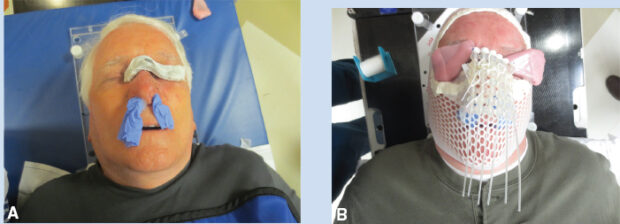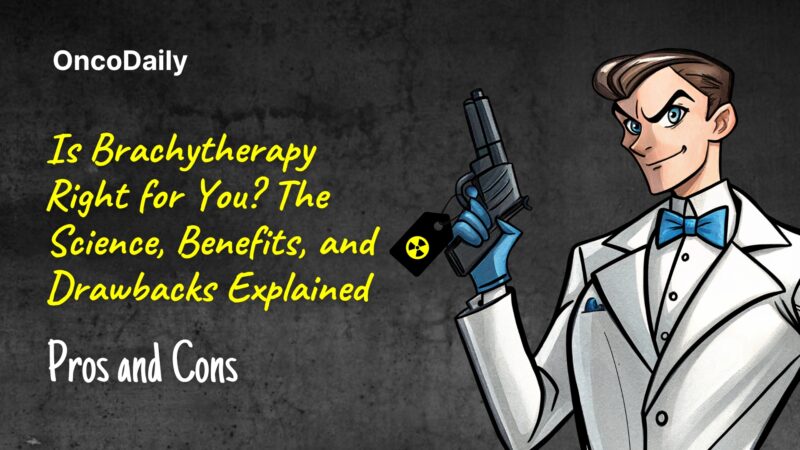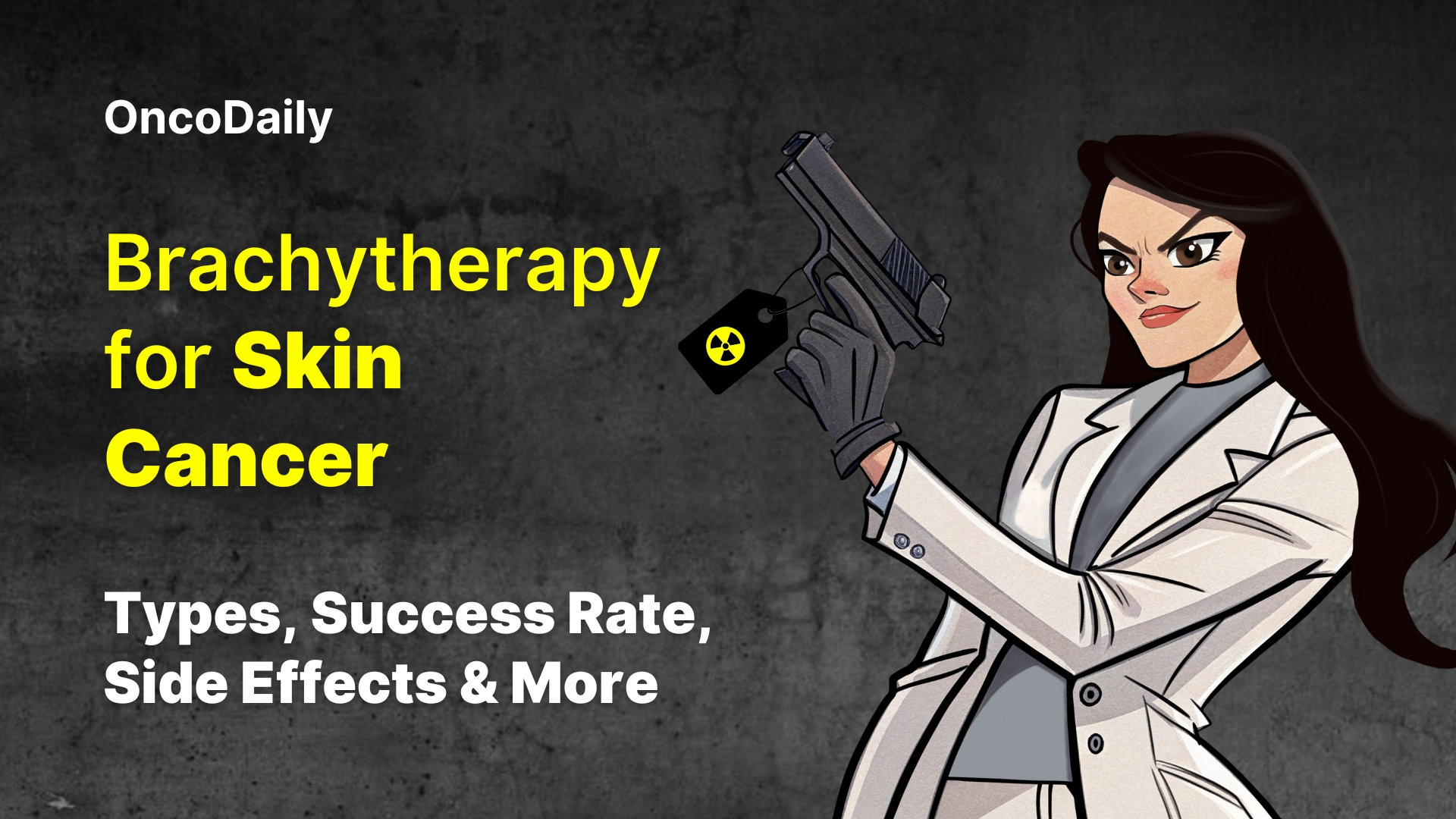Brachytherapy for skin cancer involves placing a radioactive source directly within or near the tumor, typically used for non-melanoma skin cancers like basal and squamous cell carcinoma. It is effective for small or superficial tumors, especially in areas where surgery could cause cosmetic or functional issues. The treatment delivers a precise radiation dose to the tumor while minimizing damage to surrounding tissues.
Brachytherapy is usually performed on an outpatient basis and may require one or more sessions. While generally well tolerated, side effects can include skin irritation, redness, or swelling. Success rates are high for early-stage tumors, and the treatment helps minimize scarring, making it an ideal choice for cosmetic concerns.
Types of Brachytherapy for Skin Cancer
Brachytherapy is a highly effective internal radiation treatment for skin cancers, particularly non-melanoma types like basal cell carcinoma and squamous cell carcinoma. It involves placing radioactive sources directly within or near the tumor, delivering a precise dose of radiation while minimizing exposure to surrounding healthy tissues. This method is especially beneficial for tumors located in cosmetically sensitive areas such as the head and neck.
High-Dose-Rate (HDR) brachytherapy has demonstrated excellent cosmetic outcomes and local control in treating facial skin cancers. Studies indicate that HDR brachytherapy is an efficient and well-tolerated treatment, offering low toxicity and preserving function and appearance. The treatment process typically involves outpatient sessions, each lasting about 10 to 15 minutes, delivered 2 to 3 times per week. This approach provides convenience for patients, especially those who are poor surgical candidates or have tumors in areas where surgery could cause significant cosmetic or functional impairments.
How Effective Is Brachytherapy For Skin Cancer?
Brachytherapy has emerged as an effective treatment option for non-melanoma skin cancers (NMSC), particularly basal cell carcinoma (BCC) and squamous cell carcinoma (SCC). This internal radiation therapy delivers high-dose radiation directly to the tumor site, minimizing exposure to surrounding healthy tissue.
Efficacy and Outcomes
- High Cure Rates: A study presented at the Radiological Society of North America (RSNA) in 2019 treated 70 patients aged 70 to 100 with early-stage BCC and SCC using high-dose-rate brachytherapy. The results showed a cure rate between 96% and 98%, with 90% of cases achieving excellent cosmetic outcomes.
- Cosmetic Results: A meta-analysis comparing brachytherapy (BT) and external beam radiation therapy (EBRT) found that both treatments resulted in a median of 95% of patients achieving “good” cosmetic outcomes (Zaorsky et al., 2018, Radiotherapy and Oncology).
- Local Control Rates: Research indicates that high-dose-rate brachytherapy for facial cutaneous carcinomas provides a 3-year local control rate of approximately 87% (Monge-Cadet et al., 2024, Cancers).
Advantages Over Other Treatments
- Suitability for Complex Areas: Brachytherapy is particularly beneficial for tumors located in anatomically challenging areas, such as around the ears, nose, or eyes, where surgical interventions might be complex or lead to significant cosmetic concerns.
- Patient Convenience: The treatment is typically delivered over a shorter timeframe compared to traditional radiation therapies, enhancing patient compliance, especially among the elderly
The Procedure and Preparation Steps for Brachytherapy in Skin Cancer Treatment
Before the procedure, doctors use imaging scans like CT or ultrasound to carefully plan where to position the radioactive sources for skin cancer brachytherapy. Depending on the tumor’s location, the treatment may be done with or without local anesthesia to ensure patient comfort. The medical team explains the process in detail, addressing any concerns, such as whether the radiation will remain in the body or if the procedure will cause discomfort.
During the treatment, thin applicators are positioned near or on the tumor, delivering radiation directly to the cancerous tissue. In High-Dose-Rate (HDR) brachytherapy, radiation is delivered for a few minutes and then the applicators are removed. The procedure is quick, and the radiation itself is not felt by the patient. HDR is usually performed on an outpatient basis, and most patients can return home the same day.
For Low-Dose-Rate (LDR) brachytherapy, tiny radioactive seeds are implanted, which gradually release radiation over a period of weeks. LDR may require a brief hospital stay for monitoring. Side effects are usually mild, such as slight swelling or fatigue, and generally resolve quickly.

source: www.radiologykey.com
Brachytherapy Side Effects: What Should You Expect?
Brachytherapy is an effective treatment for non-melanoma skin cancers like basal cell and squamous cell carcinoma. It delivers radiation directly to the tumor, minimizing damage to nearby healthy tissue. Most side effects are mild and limited to the area being treated.
In the short term, patients may experience redness, peeling, itching, dryness, or mild swelling at the treatment site. These symptoms usually appear within the first few weeks and tend to resolve on their own. Studies show that most patients tolerate treatment well, with high cure rates and excellent cosmetic results—especially when the cancer is caught early. To ease discomfort, gentle skin care is recommended. Patients should use non-perfumed moisturizers, avoid sun exposure, and stay away from irritants like tight clothing or harsh soaps. If itching or irritation occurs, cool compresses can help.
Some long-term side effects may appear months later. These can include changes in skin color, slight scarring, or thinning of the skin. Rarely, small visible blood vessels or ulceration may develop, particularly in high-dose areas or over bony parts like the nose or ears.
Renard et al. (2021, Brachytherapy) found that high-dose-rate brachytherapy (HDR-BT) implemented in France after the discontinuation of low-dose-rate iridium wires was efficient and well-tolerated for facial skin cancers. In 66 patients, a 98.5% complete response rate and a 3% local recurrence rate were observed after a median follow-up of 20.5 months, with good cosmetic results. Grade 3 acute dermatitis occurred in four patients and grade 3 mucositis in three patients, all resolving within 3 months.
How Long Does It Take to See Results?
The time it takes to see results from skin cancer brachytherapy depends on the type of treatment and the tumor’s characteristics. If brachytherapy is used to treat small, localized tumors, results can often be seen within a few weeks as the tumor begins to shrink or the skin heals. The full effects may take a few months to become clear, as the radiation continues to work on the cancer cells over time.
For non-melanoma skin cancers, brachytherapy is typically very effective, and patients may notice improvement in the appearance of the treated area as the tumor responds to the radiation. If the treatment is aimed at symptom relief, such as for more advanced cases, the effects can often be felt quickly, with pain or irritation decreasing in the weeks following treatment.
How Much Does Brachytherapy For Skin Cancer Cost?
The cost of brachytherapy for skin cancer can vary widely based on several factors, including geographic location, the type of skin cancer being treated (such as basal cell carcinoma or squamous cell carcinoma), and the specific medical facility where the treatment is performed.
In the United States, a typical course of brachytherapy for skin cancer can range from $5,000 to $15,000. This cost includes radiation treatment, consultations, and any imaging required. However, the price may increase depending on the complexity of the case or if additional treatments are needed, such as for more extensive tumors.
In Europe, the cost is typically lower, ranging from €2,500 to €12,000 depending on the country and whether the treatment is administered in a public or private hospital. The healthcare system in each country also plays a role in determining the out-of-pocket costs for patients, especially in countries with public health insurance that may cover a significant portion of the treatment.
In countries like India or Southeast Asia, the cost can be much lower, ranging from $1,000 to $4,000 due to lower medical costs and the availability of more affordable healthcare services.
Additional costs may arise from follow-up visits, skin care products, and any imaging (such as CT scans or MRI) required to assess the treatment area. It’s important to note that while brachytherapy for skin cancer is often covered by insurance in many regions, out-of-pocket expenses can vary greatly depending on the patient’s insurance coverage, the facility where the treatment is done, and the number of sessions required.

Read OncoDaily’s Special Article About Brachytherapy
How Does Brachytherapy Compare to Other Treatments for Skin Cancer?
Brachytherapy is a highly effective treatment option for non-melanoma skin cancers, but its suitability and effectiveness depend on the tumor’s size, location, and the patient’s overall health.
Brachytherapy for skin cancer vs Surgery
Surgery is often the primary treatment for skin cancer, especially when tumors are larger or in more accessible areas. However, brachytherapy is a great alternative when surgery could cause significant cosmetic or functional issues, especially for tumors located on the face or other sensitive areas. Brachytherapy delivers targeted radiation directly to the tumor, minimizing damage to surrounding healthy tissues and offering a less invasive approach with excellent cosmetic outcomes.
Lee et al. (2019, Cancer) compared cosmesis and recurrence rates of different treatments for early-stage skin cancers. Their meta-analysis found that brachytherapy (BT) showed the highest rate of “good” cosmesis at 97.6%, followed by MMS (96.0%), CE (81%), and EBRT (74.6%). One-year recurrence rates were low across all modalities: CE (0.8%), MMS (0.2%), EBRT (2%), and BT (0%). The authors concluded that BT and MMS offer better cosmesis than EBRT and CE, with similar local control at 1 year.
Brachytherapy for skin cancer vs Topical Treatments
Topical treatments, such as creams or gels, are used for superficial skin cancers. These treatments are generally less invasive but may not be as effective for larger or deeper tumors. Brachytherapy is more suitable for tumors that are not easily treatable with topical therapies, especially those located in challenging areas like the ears or nose. It provides more precise radiation, leading to better tumor control while preserving the skin’s appearance.
Brachytherapy for skin cancer vs External Radiation
External radiation is another option for skin cancer, where radiation is directed from outside the body. While both brachytherapy and external radiation are effective, brachytherapy allows for more focused and higher doses of radiation directly at the tumor, reducing exposure to surrounding healthy tissue. It is particularly useful for tumors in cosmetically sensitive areas, offering better outcomes with fewer side effects in comparison to external radiation.
Can All Skin Cancer Patients Receive Brachytherapy?
Not all skin cancer patients are suitable candidates for brachytherapy. The decision to use brachytherapy depends on several factors, including the type, size, and location of the tumor, as well as the patient’s overall health and the tumor’s stage. Brachytherapy is most commonly used for non-melanoma skin cancers, such as basal cell carcinoma and squamous cell carcinoma, especially in areas where surgery might cause significant cosmetic or functional issues, like the face or ears.
However, for larger or more invasive tumors, or in cases of melanoma, brachytherapy may not be the most appropriate option. In these situations, other treatments such as surgery, external radiation, or systemic therapies may be considered.
Your healthcare team will assess your individual case, including the tumor’s characteristics, to determine whether brachytherapy is the best treatment choice for you.
Innovation In Brachytherapy For Skin Cancer
Kashihara et al. (2025, Radiotherapy and Oncology) investigated boron neutron capture therapy (BNCT) for scalp angiosarcoma and malignant melanoma. In a dose escalation trial with 10 patients, BNCT up to 18 Gy-Eq was found feasible with a favorable safety profile, as only one grade 3 adverse event (transient asymptomatic increase in serum amylase) occurred. The best overall response rate within 180 days was 70%, with a median tumor shrinkage rate of 77.5%. The authors concluded that BNCT is a promising treatment option for these challenging skin cancers.
Recovery After Brachytherapy for Skin Cancer
Recovery after brachytherapy for skin cancer, such as basal cell carcinoma (BCC) or squamous cell carcinoma (SCC), generally involves allowing the treated area time to heal while gradually resuming normal activities. In the first few days following treatment, rest is important, especially to avoid irritation or injury to the treatment site. Patients are advised to avoid strenuous activities, excessive sun exposure, and picking at scabs until fully healed. Light walking is usually acceptable, as it can help maintain circulation without putting too much strain on the body.
Common side effects include redness, mild swelling, or tenderness at the treatment site, and some patients may experience dryness, itching, or peeling as the skin heals. These side effects are typically temporary and can be managed with moisturizers or topical creams recommended by the healthcare provider. It’s important to keep the treated area clean and to follow any specific skincare instructions to avoid infection or complications.
While most side effects are minor, some patients may notice changes in skin texture or discoloration, such as hyperpigmentation or hypopigmentation. These effects often resolve over time, but in some cases, they may be permanent. Fatigue can also occur, but it generally improves as the body recovers. Keeping hydrated and eating a balanced diet can help maintain energy levels and support the healing process.
How Can Patients Support Their Health During Brachytherapy for Skin Cancer?
During brachytherapy for skin cancer, patients can take several steps to support their overall health and recovery. It’s crucial to attend all follow-up appointments and follow the pre- and post-treatment instructions provided by the healthcare team. This helps ensure that the treatment is as effective and safe as possible. Patients should also report any unusual symptoms, such as increased redness, discomfort, or signs of infection, so that the medical team can address them promptly.
Common side effects of brachytherapy for skin cancer include redness, tenderness, and mild swelling at the treatment site. These side effects are usually temporary and manageable. To help alleviate discomfort, patients can apply moisturizers or topical creams recommended by their healthcare provider. Staying hydrated and eating a well-balanced diet with plenty of fruits, vegetables, and lean proteins supports healing and energy levels. Avoiding alcohol and smoking is also advised, as these can hinder the recovery process. Getting adequate rest is key, as the body needs time to heal from radiation therapy. Gentle activities like light walking or stretching can improve circulation, mood, and overall energy levels, but should only be done if approved by the healthcare provider.
Maintaining emotional well-being is just as important as physical recovery. The treatment process can be stressful, and it can help to talk to a counselor, join a support group, or share feelings with a trusted friend or family member. Patients are encouraged to ask questions about any concerns related to treatment, including cosmetic changes to the skin, potential side effects, or long-term outcomes. By staying informed and advocating for their needs, patients can feel more supported throughout the treatment process.
Written by Nare Hovhannisyan, MD
FAQ
What is brachytherapy for skin cancer?
Brachytherapy is a form of radiation therapy where a radioactive source is placed directly within or near the tumor to treat skin cancer. It allows for precise treatment while minimizing damage to healthy tissue.
What types of skin cancer can be treated with brachytherapy?
Brachytherapy is typically used for non-melanoma skin cancers like basal cell carcinoma (BCC) and squamous cell carcinoma (SCC), particularly for cancers located in hard-to-treat areas like the face, ears, or scalp.
How does brachytherapy work?
A small radioactive source is placed inside or near the tumor site, delivering a high dose of radiation to the cancer cells while sparing the surrounding healthy tissue.
Is brachytherapy safe for treating skin cancer?
Yes, brachytherapy is considered a safe and effective treatment for localized skin cancers. It is especially beneficial for tumors that are difficult to treat surgically or located in sensitive areas.
What are the benefits of brachytherapy over traditional radiation?
Brachytherapy delivers radiation directly to the tumor, reducing the risk of side effects to healthy skin and tissues. It also typically requires fewer sessions compared to traditional external beam radiation therapy (EBRT).
How long does a brachytherapy session take?
Each brachytherapy session usually lasts about 20 to 60 minutes, depending on the size and location of the tumor. The number of sessions typically ranges from one to five, depending on the specific treatment plan.
What are the side effects of brachytherapy for skin cancer?
Side effects can include redness, swelling, itching, and peeling at the treatment site. Some patients may experience mild discomfort or temporary skin changes, like dryness or pigmentation changes.
How should I care for my skin after brachytherapy?
It is important to keep the treated area clean and moisturized. Avoid direct sun exposure and follow any instructions given by your healthcare provider, such as applying specific creams or avoiding tight clothing.
Can I resume normal activities after brachytherapy?
Most patients can resume light activities within a few days, but it’s recommended to avoid strenuous exercise, heavy lifting, or sun exposure until cleared by your healthcare provider.
Is brachytherapy painful?
The procedure itself is not painful, but you may experience some discomfort or tenderness in the treated area during and after treatment. Pain can typically be managed with over-the-counter or prescribed medications.
